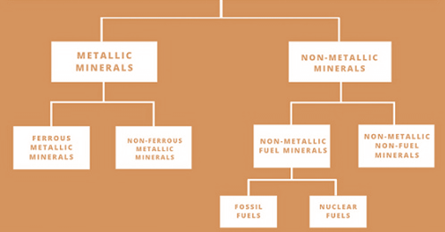Briefly explain the metallic and non-metallic mineral reserves available in India with a suitable map
Introduction:
India has a rich mineral resource. These resources can be broadly classified as metallic and non-metallic minerals. The classification can be represented as:
Body:
The major mineral resources available are as shown in the map.
Most of the metallic minerals in India are present in the peninsular plateau within the crystalline rocks. More than 97 % of the reserves of coal occur in the valleys of the rivers such as Mahanadi, Damodar, Sone, and Godavari. Petroleum reserves are located in the sedimentary basins of Assam, Gujarat and Mumbai High i.e. off-shore region in the Arabian Sea. Some new reserves have been located in the Krishna-Godavari and Kaveri basins.
The major regions where minerals are obtained in India are:
Region |
Places |
Minerals obtained |
| North Eastern Plateau | Chhotanagpur (Jharkhand), Odisha Plateau, West Bengal and parts of Chhattisgarh | Iron ore coal, manganese, bauxite, mica |
| South-Western Plateau | Karnataka, uplands of Tamil Nadu, Goa Kerala | Bauxite & Ferrous metals and Manganese and limestone. High grade iron ore |
| North-Western | Extends along Aravali in Rajasthan and part of Gujarat | Copper, zinc, sandstone, granite, marble. Gypsum and Fuller’s earth |
| Himalayan | Assam and surroundings | Copper, lead, zinc, cobalt and tungsten |
Conclusion:
The challenge of sustainable development requires integration of quest for economic development with environmental concerns. Resource consumption through the traditional methods generates enormous quantity of waste. A major problem is created in the form of threat to environment. Hence, for sustainable development we need to protect these nonrenewable resources for the future generations.








